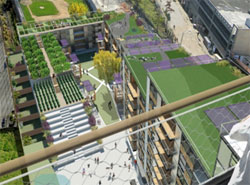Last year, New York City adopted Zone Green, which amends the city’s zoning regulations to foster green buildings.
For this effort, the city’s planning department is receiving the 2013 award for Excellence in Environmental Planning from the American Planning Association. The award honors actions that create greener communities, improving environmental quality and reducing the impact of development on the natural environment.
NYC’s zoning changes are the most comprehensive of any US city to date, intended to remove obstacles to green buildings and energy efficiency. It affects all kinds of buildings, from single-family detached homes to high-density office buildings.
"New York City is once again demonstrating leadership with creative and actionable strategies for tackling climate change with Zone Green," says Ann Bagley, Awards Jury chair for the American Planning Association. "Incentivizing green construction and retrofits, while reducing the regulatory hurdles, will benefit the citizens and business community in New York."
"While zoning often focuses on new buildings, Zone Green focuses just as much on existing buildings. In 2030, 85 percent of our buildings will be buildings that exist today – so improving the performance of existing buildings is critical to reducing New York City’s energy use and carbon emissions," says New York City Planning Commissioner Amanda Burden. "By removing prohibitions and penalties that have prevented buildings from better insulating their walls, adding solar panels on their roofs, or growing fresh, local food on rooftops, Zone Green will help bring our buildings into the 21st century while protecting the character and quality of life of our neighborhoods."

Key changes in Zone Green include:
Energy-efficient building walls: NYC has strict regulations about the size of buildings (floor area) in relation to the land they’re on. Now, building owners can add insulation to the outside of a building, without worrying about that being added to the floor area.
These changes will also preserve affordable housing because buildings can now be retrofitted with external insulation, eliminating the need to relocate existing tenants.
Solar panels, greenhouses on roofs: NYC also has strict height limits for buildings, which have been amended to leave room for a variety of uses: solar systems; greenhouses; skylights; storm water management; efficient boilers, and cogeneration facilities can be placed on roofs, without worrying about how much they add to the height of a building.
Small wind turbines are allowed above height limits on taller buildings and near the waterfront, where winds are more consistent.
Sun control devices are horizontal or vertical projections that project out from a building facade that reduce air-conditioning needs and lighting bills by providing glare-free natural light, while adding architectural interest. Previously, these weren’t allowed to project over required open areas.
Over the coming decades, enormous energy savings are expected from these zoning changes – $800 million a year from external insulation and solar panels alone.
Other changes include the option of permeable paving for schools and allowing electric vehicle charging stations in parking lots. NYC has adopted a bunch of other amendments such as making it easier for people who use car-sharing services to park on city streets, requiring new buildings to make room for bicycle parking, and requiring tree-planting for new developments.
Zone Green is the product of a task force convened in 2010, charged with developing recommendations to amend regulations that have been an impediment to green buildings.
New York City’s per-capita greenhouse gas emissions are the lowest of any major American city and buildings are the source of 75% of emissions. The goal is to reduce the city’s carbon emissions 30% by 2030.
Among the many initiatives in NYC’s sustainability plan, PlaNYC, is a requirement that every gallon of heating fuel be blended with biodiesel; 50 MW of utility-scale solar on decommissioned NYC landfills; stormwater management; requiring all buildings to measure and report on emissions; a cool roofs program; and a sweeping green buildings program.
Here’s more on Zone Green:

